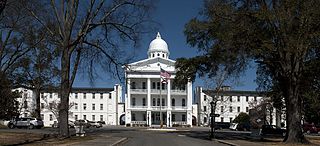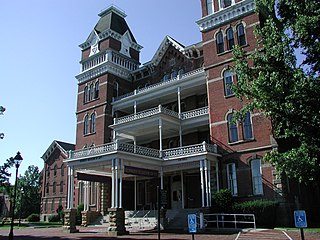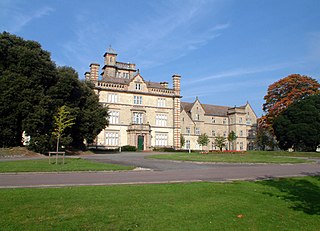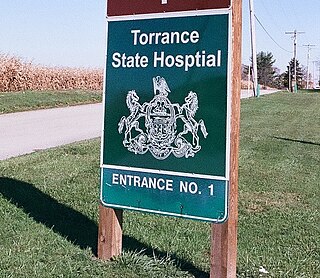
Psychiatric hospitals, also known as mental health hospitals, or behavioral health hospitals are hospitals or wards specializing in the treatment of severe mental disorders, including schizophrenia, bipolar disorder, eating disorders, dissociative identity disorder, major depressive disorder, and others.

Austin State Hospital (ASH), formerly known until 1925 as the Texas State Lunatic Asylum, is a 299-bed psychiatric hospital located in Austin, Texas. It is the oldest psychiatric facility in the state of Texas, and the oldest continuously operating west of the Mississippi River. It is operated by the Texas Health and Human Services Commission.
Lakeside Mental Hospital, originally known as Ballarat Asylum, later as Ballarat Hospital for the Insane and finally, before its closure, as Lakeside Psychiatric Hospital, was an Australian psychiatric hospital located in the suburb of Wendouree, the north-western fringe of Ballarat, Victoria, Australia.

Bryce Hospital opened in 1861 in Tuscaloosa, Alabama, United States. It is Alabama's oldest and largest inpatient psychiatric facility. First known as the Alabama State Hospital for the Insane and later as the Alabama Insane Hospital, the building is considered an architectural model. The hospital houses 268 beds for acute care, treatment and rehabilitation of full-time (committed) patients. The Mary Starke Harper Geriatric Psychiatry Hospital, a separate facility on the same campus, provides an additional 100 beds for inpatient geriatric care. The main facility was added to the National Register of Historic Places in 1977.

Pilgrim Psychiatric Center, formerly known as Pilgrim State Hospital, is a state-run psychiatric hospital located in Brentwood, New York. Nine months after its official opening in 1931, the hospital's patient population was 2,018, as compared with more than 5,000 at the Georgia State Sanitarium in Milledgeville, Ga. At its peak in 1954, Pilgrim State Hospital could claim to be the largest mental hospital in the U.S., with 13,875 patients. Its size has never been exceeded by any other facility, though it is now far smaller than it once was.

The Athens Lunatic Asylum, now a mixed-use development known as The Ridges, was a Kirkbride Plan mental hospital operated in Athens, Ohio, from 1874 until 1993. During its operation, the hospital provided services to a variety of patients including Civil War veterans, children, and those declared mentally unwell. After a period of disuse the property was redeveloped by the state of Ohio. Today, The Ridges are a part of Ohio University and house the Kennedy Museum of Art as well as an auditorium and many offices, classrooms, and storage facilities.

Fulbourn Hospital is a mental health facility located between the Cambridgeshire village of Fulbourn and the Cambridge city boundary at Cherry Hinton, about 5 miles (8 km) south-east of the city centre. It is managed by the Cambridgeshire and Peterborough NHS Foundation Trust. The Ida Darwin Hospital site is situated behind Fulbourn Hospital. It is run and managed by the same trust, with both hospitals sharing the same facilities and staff pool.

Deinstitutionalisation is the process of replacing long-stay psychiatric hospitals with less isolated community mental health services for those diagnosed with a mental disorder or developmental disability. In the late 20th century, it led to the closure of many psychiatric hospitals, as patients were increasingly cared for at home, in halfway houses and clinics, in regular hospitals, or not at all.

The Trans-Allegheny Lunatic Asylum, subsequently the Weston State Hospital, was a Kirkbride psychiatric hospital that was operated from 1864 until 1994 by the government of the U.S. state of West Virginia, in the city of Weston. Weston State Hospital got its name in 1913 which was used while patients occupied it, but was changed back to its originally commissioned, unused name, the Trans-Allegheny Lunatic Asylum, after being reopened as a tourist attraction.

The Rosewood Center was an institution for people with developmental disabilities located on Rosewood Lane in Owings Mills, Maryland.

Kew Lunatic Asylum is a decommissioned psychiatric hospital located between Princess Street and Yarra Boulevard in Kew, a suburb of Melbourne, Australia. Operational from 1871 to 1988, Kew was one of the largest asylums ever built in Australia. Later known as Willsmere, the complex of buildings were constructed between 1864 and 1872 to the design of architects G.W. Vivian and Frederick Kawerau of the Victorian Public Works Office to house the growing number of "lunatics", "inebriates", and "idiots" in the Colony of Victoria.

Sunbury Lunatic Asylum was a 19th-century mental health facility known as a lunatic asylum, located in Sunbury, Victoria, Australia, first opened in October 1879.
The Jacksonville Developmental Center was an institution for developmentally delayed clients, located in Jacksonville, Illinois. It was open from 1851 to November 2012. As of December 2012, the 134-acre (54 ha) grounds was still owned by the State of Illinois.

The lunatic asylum, insane asylum or mental asylum was an early precursor of the modern psychiatric hospital.

Central State Hospital, originally known as the Central Lunatic Asylum, is a psychiatric hospital in Petersburg, Virginia, United States. It was the first institution in the country for "colored persons of unsound mind".

Torrance State Hospital is one of six State Hospitals in the Commonwealth of Pennsylvania.

Swanbourne Hospital is a heritage listed former mental hospital located in Mount Claremont, Western Australia. Built in 1904, it was the largest stand-alone psychiatric hospital in Western Australia for much of the twentieth century until its closure in September 1972. The hospital was originally known as Claremont Hospital for the Insane, Claremont Mental Hospital and Claremont Hospital. Following the closure of Claremont Hospital in 1972, the original 1904 section of the hospital functioned as the Swanbourne Hospital until 1985. The site was vacant from 1986, until renovated and reopened primarily as an aged care residence in 2018.
Eastern State Hospital, located in Lexington, Kentucky, is the second oldest Psychiatric Hospital in the United States. It operates today as a psychiatric hospital with 239 beds providing inpatient care. Eastern State Hospital is owned by the Commonwealth of Kentucky, operated by the University of Kentucky's UK HealthCare and falls under the jurisdiction of the Cabinet for Health and Family Services.

Prestwich Hospital is a mental health facility in Prestwich, Greater Manchester, England.
State schools are a type of institution for people with intellectual and developmental disabilities in the United States. These institutions are run by individual states. These state schools were and are famous for abuse and neglect. In many states, the residents were involuntary sterilized during the eugenics era. Many states have closed state schools as part of the deinstitutionalisation movement.




















